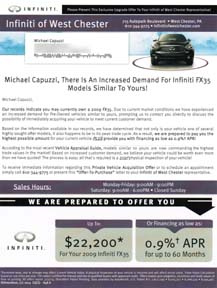Hints on how NOT to create personalized marketing
I am a huge proponent of personalized marketing for bricks and mortar and professional practice business owners and I have outlined many strategies in my High Impact Marketing Manifesto.
Study after study shows that personalized marketing (done right) increases response and results. These days with all the advanced technologies, personalized marketing can go way beyond simply inserting your recipient’s name into your piece.
The more you know about your recipient, the more opportunities you have to craft a hyper-personalized message, but personalization can be a double-edged sword and when used incorrectly, it can have a negative effect.
In this article I want to show you a specific example that appears to be on the right track, but falls way short of its goal.
Some of the best direct mail I’ve seen over the years comes from area auto-dealers, but the example I received above, while it has some merit, is not one of them (click to enlarge).
Apparently this letter went out to service customers (which I am) and at first glance it seems to do a decent job of trying to create a personalized marketing experience by sending a special offer to current customers (this strategy in and of itself is an important reminder).
Specific to the mailer above, let me first identify two positive personalized marketing things they did right.
1) They are using my name and personalizing the letter to me and not “Dear Customer.” Do not underestimate the power of putting your recipient’s name in print, especially in your headline. It was the infamous, Dale Carnegie who said, “A person’s name is to that person the sweetest and most important sound in any language.”
2) They know my year and model of my car, which is a good start, but as you're about to see, not good enough.
The first thing that struck me as odd was the way they personalized the letter. Who uses a person’s first and last name when personalizing a salutation? When you greet somebody, you typically don’t say “Hi John Smith.”
It’s not a normal way to communicate and rather than have the intended reaction, it’s a speed bump.
But it’s not the BIG personalized marketing mistake they made.
The big mistake they made was dramatically devaluing my car by not taking into account the specific details of the model I own, which if they did would completely change their value (as a side note, I’ve bought and sold may cars and trucks over the years and consider myself rather savvy when it comes to the value of vehicles, so as soon as I saw the “offer they prepared for me”, they instantly lost all credibility with me).
Here are a few hints on how I would have crafted this personalized marketing piece to do a better job.
1 - Use the appropriate “name format” choice for the tone of your piece. While this is not easy to manage, you need to be aware of it. Many people have a formal name (e.g. Michael) and their day-to-day name (e.g. Mike) and the more you strategic you are in your use of the right form, the better your marketing will be.
Trust me, I have done my share of updating our customer database when I see this happening and given the type of marketing I do, I prefer to use informal names. Depending on how you capture somebody’s information, you may not be able to get around this reality. However, the High Impact Marketer will go the extra step and ask customers and prospects for the name they prefer to be addressed by and use it correctly in their marketing.
2 - Use first-name only or last-name only depending on your desired tone and audience. For more friendly-sounding marketing, use only a person’s first name in your headline, salutation and body copy.
Depending on your business, age of your recipients, etc. it may be more appropriate to have a more formal tone and use a person’s last name with correct title (e.g. Mr., Mrs., Dr., etc.). This requires you to know the correct title to use, so make sure you capture it.
3 – If you’re using hyper-personalized data, make sure you have it right. As I mentioned above, the potential pitfall with hyper-personalizing marketing is that you can get it wrong. If you are going to go the extra step and include very specific information in your personalized marketing campaigns, make sure you have it right. This requires you to capture the information correctly and review the information before sending out.
4 – Personalize who the letter is coming from. Another mistake, in my opinion, is the generic sender of this letter. It would have taken zero effort to have this letter come from my service representative, the dealer owner, etc.
Personalized marketing that is “me to you” is a building block of High Impact Marketing and should be used strategically by all business owners. The big caveat is to use it correctly and in a way that sound natural and normal. Effective personalized marketing enhances the marketing experience and doesn’t derail it.


Hey, MIke —
Good stuff. Simple. Elementary. But valid and a good reminder of what we OUGHT to be doing.
Thanks for your usual insightful thoughts.
Jim
Jim – you are welcome! Thanks.
Hey Mike,
I was reading your latest post. You said, “Study after study shows that personalized marketing (done right) increases response and results.” I would have said, (done right and would have added… done consistently.) I feel like so many people do one mailing, then expect the BIG RESULTS. I have to say, everyone at one time or another gets lazy, or just takes things for granted. With your blog and your emails they help people like me to stay focused and do the simple things that will increase our income. I appreciate everything you do and you’re the best. Great stuff. Dr. Carney